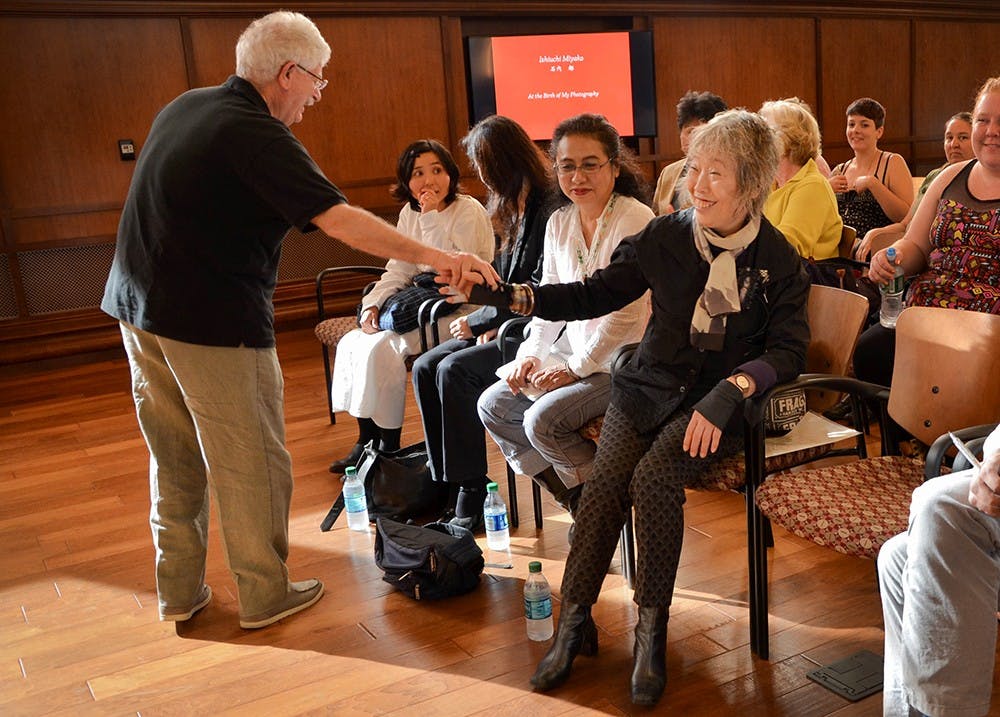For Miyako Ishiuchi, photography was a means for her to communicate with her late mother and the women lost in the World War II atomic bombing of Hiroshima.
Ishiuchi covered this topic last night in her “At the birth of my photography” lecture tucked off Kirkwood Avenue in Franklin Hall.
According to the School of Fine Arts, Ishiuchi was recently awarded the 2014 Hasselblad Award, the highest international achievement in photography.
In 2005, she showed her work “Mother’s – Traces of the Future” at the Venice Biennale. The Biennale is an event that occurs in Venice, and according to its website, organizes international events in the field of the contemporary arts that are among the most important of their kind in the world.
It was there where she got her initial launch into what would eventually lead to her current work, the yearly photography of World War II era clothing. However, to get to clothes, Ishiuchi first stripped her photography down to the skin.
***
She started photography at 19, however her career did not really launch into what it is today until age 40.
At that age, she hit a slump. She established herself in her home town of Yokosuka by taking pictures of scenery, architecture and the red light district.
“What is 40 years and how do I understand that,” she said to the audience through her translator.
She found her answer by taking photos of 40-year-old women’s hands and feet. The series was titled “1947,” the year of Ishiuchi and her ?models’ birth.
“I felt like as I was looking at hands and feet,” she said. “I could see the accumulation of those 40 years.”
As hands and feet are extensions of the body, Ishiuchi said she felt as if she could see the entirety of those women’s lives in their skin.
It was there where her fascination with the human body began. To take it one step further, she launched a series on scars.
“Scars really, when you look at them, they are an accumulation of the past and history,” she said. “When you look at them, they are sort of proof that you are alive.”
On the screens behind her was a large image of a woman’s bare torso. It was cropped, to just pass her breasts, run down her ribs and end at her hips.
A long, vertical gash sliced approximately six inches down the woman’s stomach. Another scar pushed surrounding skin up and to the side due to the way it healed.
“I started to think that scars are almost like photographs in the memories that they carried,” she said.
From there, she moved to her “Innocence” series. In this series, the key photo took the viewer a step back, showing a woman’s nude body from the thighs up.
Her head was cropped out. Sprinkled under her arm and around her hip were large burns. She was burned with boiling water in an accident as a child.
***
In 2000, during the “Innocence” series, her mother died. After her mother’s funeral, she became fascinated with photographing her mother’s lingerie.
Ishiuchi said she was never close with her mother while she was alive. They never communicated, she said.
However while she was working with her mother’s undergarments she felt as if her mother was still there.
Philosophically, Ishiuchi said undergarments were like a person’s second skin.
When she took those photos, even though her mother was gone, Ishiuchi felt as if there was a permanent piece of her that remained and could never go away.
“I started doing this in order to really communicate with my mother, whom I never communicated with,” she said. “I was sort of able to open a channel of ?communication.”
Those delicate pictures of lace through a bright window, among other photos in her “Mother’s Traces of the Future” series brought Ishiuchi to her current work of today.
***
Every year, Ishiuchi visits Hiroshima to photograph vintage World War II clothing. It first started after her “Mother” series caught the attention of a museum in Hiroshima.
They brought her in to take pictures of their collection’s clothing in a similar style to her mother’s photo series.
Much like with her mother, she felt a connection to the women who at one point, owned the clothing.
“I felt a conversation from the objects of the remains of the person,” she said.
One of the first photographs shown was the image of a tattered black dress against a homemade light box. Since then, donations of clothing piled up and Ishiuchi returned to photograph the new additions.
One of her latest images was the photo of a white short-sleeved sweater that had survived the bombing tucked in a woman’s wardrobe. Its owner had not.
Ishiuchi frequently brought up one point in her lecture. Despite taking images of historical clothing, she never wanted people to think her work was documenting history.
This is again not a documentary, these are images of how I saw and felt something while looking at the object, she said.
“So in photographing, I don’t feel like I’m recording things about Hiroshima,” she said. “I feel more like I am recording time.”






